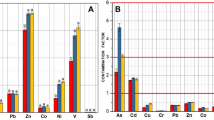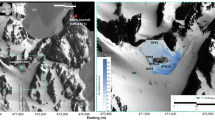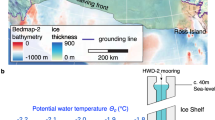Abstract
Chemotaxis allows microorganisms to rapidly respond to different environmental stimuli; however, understanding of this process is limited by conventional assays, which typically focus on the response of single axenic cultures to given compounds. In this study, we used a modified capillary assay coupled with flow cytometry and 16S rRNA gene amplicon pyrosequencing to enumerate and identify populations within a lake water microbial community that exhibited chemotaxis towards ammonium, nitrate and phosphate. All compounds elicited chemotactic responses from populations within the lake water, with members of Sphingobacteriales exhibiting the strongest responses to nitrate and phosphate, and representatives of the Variovorax, Actinobacteria ACK-M1 and Methylophilaceae exhibiting the strongest responses to ammonium. Our results suggest that chemotaxis towards inorganic substrates may influence the rates of biogeochemical processes.
Similar content being viewed by others
Log in or create a free account to read this content
Gain free access to this article, as well as selected content from this journal and more on nature.com
or
References
Adler J . (1969). Chemoreceptors in bacteria. Science 166: 1588–1597.
Adler J, Dahl MM . (1967). A method for measuring the motility of bacteria and for comparing random and non-random motility. J Gen Microbiol 46: 161–173.
Azam F . (1998). Microbial control of oceanic carbon flux: the plot thickens. Science 280: 694–696.
Barbara GM, Mitchell JG . (2003). Marine bacterial organisation around point-like sources of amino acids. FEMS Microbiol Ecol 43: 99–109.
Blackburn N, Fenchel T, Mitchell JG . (1998). Microscale nutrient patches in plankton habitats shown by chemotactic bacteria. Science 282: 2254–2256.
Boin MA, Austin MJ, Hase CC . (2004). Chemotaxis in Vibrio cholerae. FEMS Microbiol Lett 239: 1–8.
Caporaso JG, Bittinger K, Bushman FD, DeSantis TZ, Andersen GL, Knight R . (2010). PyNAST: a flexible tool for aligning sequences to a template alignment. Bioinformatics 26: 266–267.
Church MJ . (2008). Resource control of bacterial dynamics in the sea. In: Kirchman D (ed). Microbial Ecology of the Ocean. 2nd edition, John Wiley & Sons, Inc: Hoboken, NJ, USA.
Del Rio TG, Abt B, Spring S, Lapidus A, Nolan M, Tice H et al (2010). Complete genome sequence of Chitinophaga pinensis type strain (UQM 2034T). Stand Genomic Sci 2: 87–95.
Falke JJ, Hazelbauer GL . (2001). Transmembrane signaling in bacterial chemoreceptors. Trends Biochem Sci 26: 257–265.
Fenchel T . (2002). Microbial behaviour in a heterogenous world. Science 296: 1068–1071.
Hütz A, Schubert K, Overmann J . (2011). Thalassospira sp. isolated from the oligotrophic eastern Mediterranean Sea exhibits chemotaxis toward inorganic phosphate during starvation. Appl Environ Microbiol 77: 4412–4421.
Ingham CJ, Armitage JP . (1987). Involvement of transport in Rhodobacter sphaeroides. J Bacteriol 169: 5801–5807.
Jamieson WD, Pehl MJ, Gregory GA, Orwin PM . (2009). Coordinated surface activities in Variovorax paradoxus EPS. BMC Microbiol 9: 124.
Kearns DB, Shimkets LJ . (1998). Chemotaxis in a gliding bacterium. Proc Natl Acad Sci USA 95: 11957–11962.
Kennedy MJ, Lawless JG . (1985). Role of chemotaxis in the ecology of denitrifiers. Appl Environ Microbiol 49: 109–114.
Lee DY, Ramos A, Macomber L, Shapleigh JP . (2002). Taxis response of various denitrifying bacteria to nitrate and nitrite. Appl Environ Microbiol 68: 2140–2147.
Lim JH, Baek SH, Lee ST . (2009). Ferruginibacter alkalilentus gen. nov., sp. nov. and Ferruginibacter lapsinanis sp. nov., novel members of the family ‘Chitinophagaceae’ in the phylum Bacteroidetes, isolated from freshwater sediment. Int J Syst Evol Microbiol 59: 2394–2399.
Malmcrona-Friberg K, Goodman A, Kjelleberg S . (1990). Chemotactic responses of marine Vibrio sp. Strain S14 (CCUG 15956) to low-molecular weight substances under starvation and recovery conditions. Appl Environ Microbiol 56: 3699–3704.
Meier VM, Muschler P, Scharf BE . (2007). Functional analysis of nine putative chemoreceptor proteins in Sinorhizobium meliloti. J Bacteriol 189: 1816–1826.
Miller TR, Hnilicka K, Dziedzic A, Desplats P, Belas R . (2004). Chemotaxis of Silicibacter sp. strain TM1040 toward dinoflagellate products. Appl Environ Microbiol 70: 4662–4701.
Montrone M, Eisenbach M, Oesterhelt D, Marwan W . (1998). Regulation of switching frequency and bias of the bacterial flagellar motor by CheY and fumarate. J Bacteriol 180: 3375–3380.
Nealson KH, Moser DP, Saffarini DA . (1995). Anaerobic electron acceptor chemotaxis in Shewanella putrefaciens. Appl Environ Microbiol 61: 1551–1554.
Newton RJ, Jones SE, Helmus MR, McMahon KD . (2007). Phylogenetic ecology of the freshwater Actinobacteria acI lineage. Appl Environ Microbiol 73: 7169–7176.
Poole PS, Armitage JP . (1989). Role of metabolism in the chemotactic response of Rhodobacter sphaeroides to ammonia. J Bacteriol 171: 2900–2902.
Steyn PL, Segers P, Vancanneyt M, Sand P, Kersters K, Joubert JJ . (1998). Classification of heparinolytic bacteria into a new genus, Pedobacter, comprising four species: Pedobacter heparinus comb. nov., Pedobacter piscium comb. nov., Pedobacter africanus sp. nov. and Pedobacter saltans sp. nov. Proposal of the family Sphingobacteriaceae fam. nov. Int J Syst Bacteriol 48: 165–177.
Stocker R . (2012). Marine microbes see a sea of gradients. Science 338: 628–633.
Stocker R, Seymour JR . (2012). Ecology and physics of bacterial chemotaxis in the ocean. Microbiol Mol Biol Rev 76: 792–812.
Stocker R, Seymour JR, Samadan A, Hunt DH, Polz M . (2008). Rapid chemotactic response enables marine bacteria to exploit ephemeral microscale nutrient patches. Proc Natl Acad Sci USA 105: 4209–4214.
Szurmant H, Ordal GW . (2004). Diversity in chemotaxis mechanisms among the bacteria and archaea. Microbiol Mol Biol Rev 68: 301–319.
Thauer RK, Jungerman K, Decker K . (1977). Energy conservation in chemotrophic anaerobic bacteria. Bacteriol Rev 41: 100–180.
Warnecke F, Amann R, Pernthaler J . (2004). Actinobacterial 16S rRNA genes from freshwater habitats cluster in four distinct lineages. Environ Microbiol 6: 242–253.
Weon HY, Yoo SH, Kim BY, Son JA, Kim YJ, Kwon SW . (2009). Niabella ginsengisoli sp. nov., isolated from soil cultivated with Korean ginseng. Int J Syst Evol Microbiol 59: 1282–1285.
Willey JM, Waterbury JB . (1989). Chemotaxis toward nitrogenous compounds by swimming strains of marine Synechococcus spp. Appl Environ Microbiol 55: 1888–1894.
Acknowledgements
We thank Philip Hugenholtz for advice on the manuscript. PGD acknowledges financial support from the Commonwealth Scientific and Industrial Research Organisation. GWT is supported by an ARC Queen Elizabeth II fellowship (DP1093175).
Author information
Authors and Affiliations
Corresponding author
Ethics declarations
Competing interests
The authors declare no conflict of interest.
Additional information
Supplementary Information accompanies this paper on The ISME Journal website
Supplementary information
Rights and permissions
About this article
Cite this article
Dennis, P., Seymour, J., Kumbun, K. et al. Diverse populations of lake water bacteria exhibit chemotaxis towards inorganic nutrients. ISME J 7, 1661–1664 (2013). https://doi.org/10.1038/ismej.2013.47
Received:
Revised:
Accepted:
Published:
Issue date:
DOI: https://doi.org/10.1038/ismej.2013.47
Keywords
This article is cited by
-
Characterization of two keystone taxa, sulfur-oxidizing, and nitrate-reducing bacteria, by tracking their role transitions in the benzo[a]pyrene degradative microbiome
Microbiome (2023)
-
Indole decreases the virulence of the bivalve model pathogens Vibrio tasmaniensis LGP32 and Vibrio crassostreae J2-9
Scientific Reports (2022)
-
Dispersal-competition tradeoff in microbiomes in the quest for land colonization
Scientific Reports (2018)
-
Selective isolation and characterisation of novel members of the family Nocardiopsaceae and other actinobacteria from a marine sediment of Tioman Island
Antonie van Leeuwenhoek (2018)
-
Brown Rot Syndrome and Changes in the Bacterial Сommunity of the Baikal Sponge Lubomirskia baicalensis
Microbial Ecology (2018)



